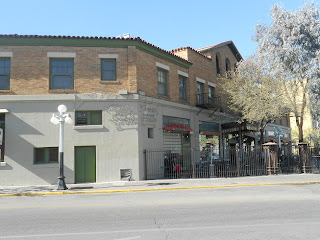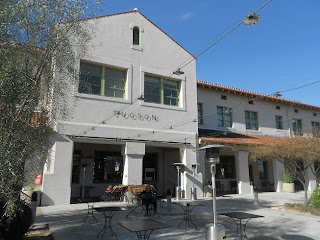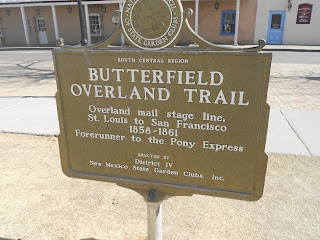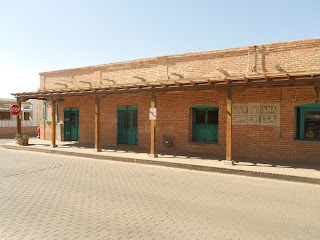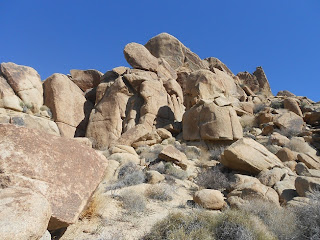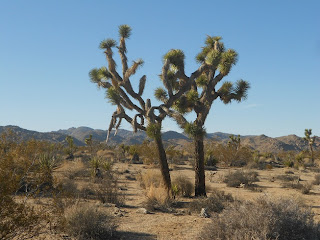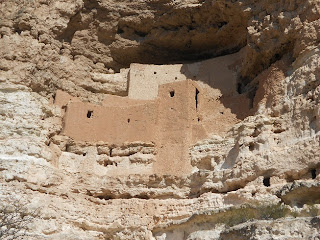Western Trips makes a visit to Benson Arizona, a town whose history goes back to the days of Wyatt Earp and old Tombstone Arizona as well as to the building of the Southern Pacific Railroad. Benson history is truly that of the old west and if you happen to be traveling through southern Arizona it's a stop you want to make.
 |
| Benson Arizona train station and Visitors Center |
The earlier settlement in the area was named the San Pedro River Station on the east bank of the San Pedro River. The San Pedro River has the distinction of being one of only two rivers which flow north from Mexico into the United States. A tribe of Pima Indians called the Sobaipuri who had dwelt there for several hundred years inhabited the San Pedro Valley. A Spanish missionary, Father Kino brought Spanish culture to the San Pedro Valley in 1692. This was years after the Spanish had already settled into New Mexico up along the Rio Grande. Father Kino brought with him not only the missionaries but also herds of cattle.
A Stop on the Butterfield Stage Route
The Butterfield Stage Line followed what was referred to as the Butterfield Trail through southern Arizona. The Butterfield stage depot was constructed in the late 1850's about one mile north of the present day Benson. This depot required fortification and housed eight soldiers and provided a stopover east of Tucson. As many know, the Butterfield Overland Mail Stage Line had a short lifetime due to the outbreak of the American Civil War. The Butterfield Stage Line was quite unique in as much it traveled the southern route from Missouri to San Francisco in some twenty-six days. The federal mail contract is what put Butterfield in business with passenger transportation being a secondary factor.
 |
| Downtown Benson AZ |
The Benson-Tombstone Stage Robbery
Almost anyone who has delved into the old west history of southern Arizona has heard about the stage robbery on the Benson-Tombstone Stage Route in 1881. The robbery took the life of stagecoach driver Bud Philpot and became one of the events that led to the Earp-Clanton gunfight at the O.K. Coral.
Interestingly enough, a good part of the old Benson to Tombstone Stage Road still exists today. Some of the route passes through ranch land and other portions through BLM land. During the late 1800's the stage road to Tombstone made a stop at what is today the old silver mining ghost town of Contention City in Cochise County. Today only a few foundations and adobe walls can be found there. The ghost town is now part of the San Pedro Riparian National Conservation Area and is managed by the BLM.
Eventually, a Wells Fargo stagecoach station was established in Benson in 1885.
Events for your Trip Planner
Two Annual Events in southern Arizona to add to your vacation planner include Vigilante Days in Tombstone Arizona On August 9th and 10th 2013. This annual event commemorates a part of Tombstone's unique heritage. Activities include a 10k run, reenactments, street entertainment, gunfight competitions, hangings and a chili cook-off. For more information visit their web site at www.Tombstone Vigilantes.com
Another date to mark on your calendar is the Benson Overland Stage Festival and Car Show. The date is Sunday October 12th and 13th 2013. On October 12th and 13th will also be the Benson Rodeo. For more information visit website www.bensonvisitorcenter.com
 |
| Horse Shoe Cafe, a great dining stop in Benson |
The building of the Southern Pacific Railroad meant the founding of Benson in 1880. Benson history has everything to do with the railroad in as much as the town is named after Judge William S. Benson of California who was a friend of Charles Crocker, president of the Southern Pacific. Crocker was one of the Big Four who built the Central Pacific Railroad which represented the western leg of the first transcontinental railroad.
The gold and silver mining was the original basis for the Benson economy. Several more rail lines were built into Benson that it became somewhat of a railroad hub. For instance, In 1881, Benson became the terminus for the Sonoran Railroad, built by the Santa Fe Railroad, that ran all the way up from the seaport of Guaymas, Mexico. With this amount of traffic and people going through Benson, hotel, saloons, livery stables, merchandising establishments and restaurants grew considerably.
 |
| Late 1800's photo of Benson's Southern Pacific RR Station |
When you visit Benson Arizona you'll also want to plan a visit at Kartchner Caverns State Park. This is an amazing limestone cave that was discovered in 1974. This is actually a "living cave". Calcite formations continue to grow. Tour guides will offer a fascinating glimpse of this underground landscape. Camping and picnic space is also available. Kartchner Caverns State Park is located 45 miles east of Tucson and 13 miles south of Benson on State Hwy 90.
Links to two additional Western Trips photo articles you'll enjoy are Old Town Tucson and the Tombstone Epitaph.
Benson Arizona Visitors Center
Today, the Benson Arizona train station, also the Amtrak station, which serves the Amtrak Sunset Limited, is filled with all the information you need to have a rewarding and fun visit. The Sunset Limited runs between Los Angeles and New Orleans. The Benson Arizona Visitors Center is located in the middle of town at 249 E. 4th Street. The Visitors Center prides itself at being a beautiful replica railroad depot using many of the same architectural features as the original depot that was built over 100 years ago.
If you're traveling through southern Arizona there's a great deal of interesting stops that were part of the great American western expansion. Lots of historical sites and interesting museums. Benson Arizona is one you'll definitely want to add to your Arizona trip planner.
(Photos from author's private collection)
View Larger Map



